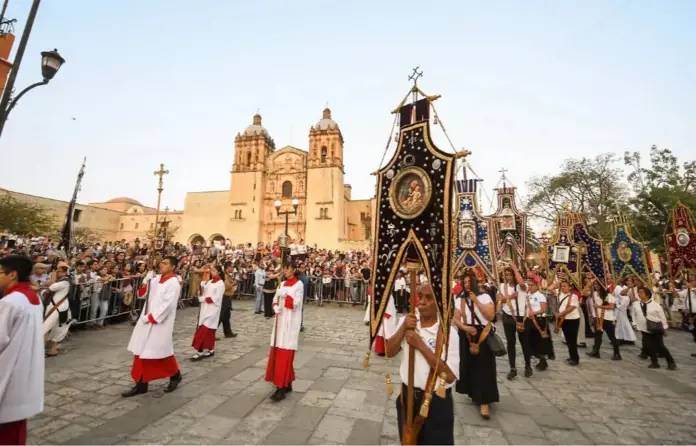Oaxaca celebrates today, April 25th, its 493rd anniversary of being elevated to the status of city, aggrieved and threatened by street vendors, graffiti, marches, blockades, sit-ins, crime, lack of water, and garbage—”active enemies” that jeopardize the city’s 1987 UN World Heritage status, warns city chronicler Jorge Bueno Sánchez.
In an interview with El Sol de México, the writer also says that Oaxaca faces all the ills of a society and calls on Oaxacans to remain united to preserve and care for what we have as material, spiritual, and cultural values.
Oaxaca reaches adulthood—because we are a few years away from celebrating five centuries as a city—with an enormous past history, a Mesoamerican culture complete in every aspect, the intellectual points out.
“Over the centuries, the city grew from 30 inhabitants to 500; the nomenclature was limited to the Castizos (white-skinned people). Later, a census was also taken on clothing, and so on, little by little, but excluding the indigenous classes who didn’t even have the right to vote or the right to education,” he says.
And he adds: “Oaxaca grew over time; its Castizo construction was manifested in temples and manifested in civic life through its large buildings like the town hall. Oaxaca, over time, was perfectly laid out by Alonso García Bravo. It’s a city whose growth developed throughout the Valley. Originally, Oaxaca had a language from one point of intersection for all four cardinal points, but it never reached that size; its growth was slow.”
We have, Bueno Sánchez maintains, an old city, like every viceregal city, with problems of street vendors, garbage, and lack of water. We are not an entity that can escape reality. Insecurity also exists, although to a lesser extent.
“As in other states, insecurity also manifests itself, and we have bloody Saturdays and Mondays, but we are truly the city where tourism can be enjoyed. National and international tourists can come and walk the streets, they can rest easy, because violence occurs in certain areas, such as agrarian conflicts, which continue to exist.”
The city chronicler notes that Oaxaca’s growth also brought with it a lack of sufficient water. Although it has three aqueducts, and well drilling began in 1962, today it faces problems during the dry season.
Although there are water sources that allow for regular water supplies, which previously occurred around the clock, with the arrival of Morena to the municipal government for two consecutive three-year terms and now the Green Ecologist Party, water supply periods have been spaced out by up to 30 and 40 days in the Historic Center and the surrounding neighborhoods.
To commemorate the 493rd anniversary of the city’s elevation to city status, various cultural, artistic, and musical activities were planned. The Rodolfo Morales Spring Festival was also reactivated for this occasion, in honor of the illustrious Oaxacan painter, who would have turned 100 this year.
On this day, starting at 6:45 a.m. in the Alameda de León, the traditional Mañanitas were sung to the city, accompanied by the ringing of bells, a concert by the City Choir, and the participation of the State Music Band. There was also a performance by tenor Rodrigo Petate, the joy of the Chinas Oaxaqueñas, and a tasting of tamales and atole.
At 10:00 a.m., the Solemn Session of the Oaxaca City Council took place at the Macedonio Alcalá Theater. This commemorative civic event reflected on the historical and cultural value of the city, where recognitions were given to personalities who have contributed to the city’s development.
The city chronicler highlights that, on each anniversary, concerts, lectures, and performances by artists who sing to the Great Lady of Oaxaca are held in the morning, afternoon, and evening. He recalls that in 1932, the Racial Tribute, which is now known as the Guelaguetza, was born as an idea to pay homage to the Great Lady, who on that occasion turned 400 years old.

Does our city arrive at this anniversary wounded or mortally wounded?
—For many years, the city was wounded by earthquakes, wounded by the revolution that affected its sovereignty in Oaxaca. Today, the city faces serious problems, painful for a society that pays its taxes for street sweeping and garbage collection, water supply, and security.
—In Oaxaca, situations arise that cannot be avoided because they are individuals from other states, such as Veracruz, the State of Mexico, or Chiapas, who come to commit crimes or are fleeing, or they see that the city has economic prospects for them. That’s why I think this phenomenon occurs. But it’s not that organized groups exist here in Oaxaca, groups that charge a fee. They come and make themselves felt as Colombians who come to rob houses. They are apprehended, taken to prison, and lawyers get them out. It’s a problem that the laws sometimes protect criminals more than citizens.
Jorge Bueno Sánchez argues that one of the most sensitive aspects is the state of monuments and historical sites. Protests, especially feminist ones, have caused damage to temples such as the Cathedral and museums.
Furthermore, the theft of plaques, busts, and historical artifacts is a persistent problem, often caused by people with alcohol or drug addiction problems. Iconic monuments, such as the Águilas de Porfirio Díaz or commemorative plaques, have been looted or damaged, putting the integrity of Oaxaca’s tangible heritage at risk.
He concludes that Oaxaca’s declaration as a World Heritage City by UNESCO, granted more than 30 years ago, has been jeopardized several times, and specifies that the protection of its monumental area and cultural heritage requires a constant effort by authorities and society to prevent economic interests, corruption, or negligence from jeopardizing this international recognition.

Source: oem




